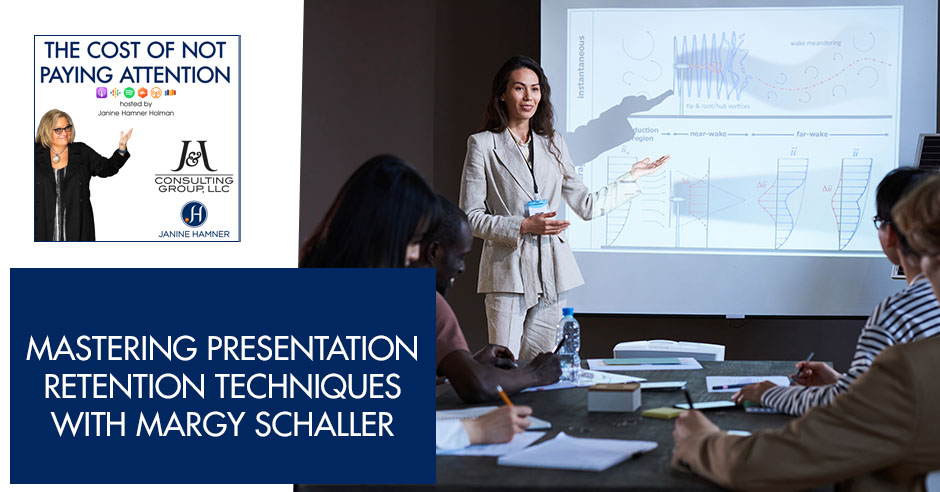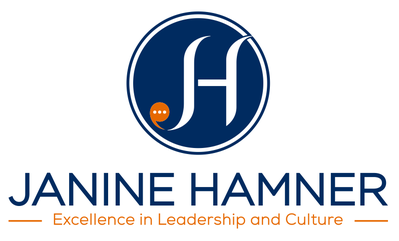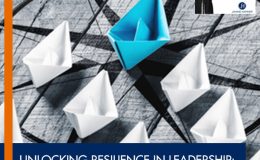
Discover the secrets to effective memory retention in your presentations with Margy Schaller, known as the Confidence Whisperer. In this episode, Janine Hamner-Holman delves into the techniques and strategies that can transform the way your audience remembers your content. Learn how to captivate and engage listeners, ensuring they retain the most critical information long after your talk ends. Join us as Margy shares her insights on clarity, relevance, and interactivity to enhance your presentation skills.
GUEST: Margy Schaller | LinkedIn | Website
HOST: Janine Hamner Holman | [email protected] | LinkedIn, Facebook, and Twitter | Subscribe to my Newsletter! | Book me to Speak!
—
Listen to the podcast here
Mastering Presentation Retention Techniques With Margy Schaller
Janine: Welcome to the Cost of Not Paying Attention. I’m your host, Janine Hamner Holman. We all have things that we want to say.
Things that we want to make sure that other people hear. Margy Schaller, known as the confidence whisperer, is here to help us ensure that people pick up what we are putting down. Because the reality is that people only remember 10% of what we say. Margy’s content coaching and slide design work are known as game changers by speakers and presenters far and wide.
So Margy, what is the one thing that you have realized either within your business or with your clients? What’s the one thing that they’ve been failing to pay attention to? And what’s the problem that inattention is causing?
Margy: I work with speakers who put so much time and so much energy into bringing their expertise to their audiences. Yeah. And after all that work and all that time and all that energy, as you said, people don’t remember more than about 10%.
Janine: Which is so sad, because I am one of those people who spend so much time on slide content and, and speaking content to make sure that people get all the stuff, and then they only remember 10% of what we say.
Margy: And this is not new news.
Janine: It’s such bad news that my brain wants to forget it!
The Forgetting Curve And Its Impact
Margy: Yeah, back in the 1800s, Herman Ebringhaus created what we now call the forgetting curve. And what he did was he did memory studies. These were tests where he documented over time how much people retained.
And the forgetting curve literally is this dramatic fall off within hours. But really down to the 10% within about a week of what we’ve heard.
And this study has been repeated over time, and over and over. I Even found one as recently as about 10 years ago and the data still stands.
Janine: So that’s terrible news. What do we do to change that? Because whether it’s a conversation with our spouses, children, or our boss… or you’re like me; You’re getting up and you’re doing a keynote presentation. We’re all having conversations with people all the time and we want to make sure that they get the message and remember what we’re talking about.
So, without obviously giving away the farm, because if people really want to get all that you offer, they need to hire you. But, beyond that, what are some tips, tricks, or ideas about how we can help ensure that the things that we want them most to remember are the things that they get?
Margy: Well, not giving away the farm because I didn’t create this, but there really are four key things that have been researched along with all of this that make that forgetting curve a little less painful for us. So I’m going to say what the four are, but then we can kind of dig into them.
Importance Of Clarity
Number one, clarity. If we are not super easy to understand, then people are not going to remember it. We’ll go into that in a second because that’s a big one. The second one is relevance. As adults, we have so much coming at us we’re more likely to work, to remember the things that matter to us. The third is reinforced learning over time. And the fourth thing is interactivity that so many studies show that passive listening, literally, it’s almost just like you can watch things falling out of people’s heads and when it’s experiential, it’s a whole distinct thing.
So I’m going to go back to clarify. We, as Americans really, like to couch things in all kinds of words. We like to lead up with this long runway to jump off of a very short pier. And we think that’s easy to get along with putting the sandwich around the meat. But if you really want somebody to remember something, we need to be crystal clear with what that is.
To make people remember something, we need to be crystal clear about what that is. Simplicity is key. Share on XJanine: Does it help when we do things… like one of the things that I do as a keynote speaker is, if I really want them to remember something, I’ll get loud or quiet. Or sometimes I speak really slowly. Do those kinds of tricks get the brain to pay a bit more attention? Do those kinds of things actually work?
Margy: They do help with getting the brain to pay attention. So what you’re talking about is the reticular activating system. The RAS is as it’s known. Billions of sensory inputs coming at us a second and the RAS is sort of like the air traffic controller telling all that information where to go. If it sees something that it’s seen before, it goes, “Oh, I don’t need to pay attention to that.” It’s almost like driving down the highway, and suddenly you sort of come to, and you realize you’ve been driving in a sort of blackout.
Janine: Yes! Or like I am suddenly sitting at my desk and I cannot remember getting to my desk.
Margy: Yes! That’s because the RAS has said, “Oh, I’ve done this a hundred times before. I don’t need to pay that close attention.” But if a car were to come towards you, you would instantly “wake up” and be able to handle it. Same thing happens when our spouse is talking to us, or when our boss is talking to us, or when we’re talking from a podium.
If it sounds the same all the time, if it looks the same all the time, the brain goes, Oh, I’ve heard this before. I’m going to go into a blackout because it conserves energy.
Janine: Got it.
Margy: Those switches in pace or those switches in volume. That’s when the brain goes, “Did a car swerve closer to me?”
That’s a fabulous way to get the brain to wake back up again. Remember, the brain’s job is to conserve energy because it would overheat. It would fry itself if it paid attention to everything, all the time. If we make the brain work too hard, it’s going to zone out. How many times have you sat in a lecture and thought, “Where are they going with this?” They’re going on and on and you’re begging them in your head to get to the point because it almost hurts to process the information, it’s too hard. So instead of working too hard, it will just shut down. All the things to reduce the forgetting curve. The goal is to make it easy for people to understand and remember what you want them to.
Janine: One strategy that exists that I don’t use because I don’t like it, but I’m totally open to you telling me to get over it… It exists for a reason, you tell the listener what you’re going to tell them before you actually tell them.
You tell them the thing, and then you tell them what you told them.
I hate it! So do I need to get over it and make sure that I tell them three times, or are there more clever ways to set them up to listen?
Margy: Yeah, that is a very simple way to do things. It’s a very old school tactic, but there are things about old school methods that are good. When you’re crafting your speech or script, I think it’s better to focus on knowing the 10% that you want people to remember. Have you selected the 10% and then is everything else in service to that or just other interesting things that are like detours?
Like, “Oh this is a cool thing you should know…” if those are not in service to your 10%, then all of it is getting diluted.
Janine: Wow.. so when I hear that -as a keynote speaker, I want to ensure that people are getting value for I want a pocket full of information. Because our brains are very clever, my brain says, I’ll just make the 10% something really big and then I’ll push everything else into that 10%. I make the 10% into the world’s biggest umbrella and everything else hangs off of that. I have a strong hunch that’s what you’re telling me exactly not to do?
Margy: I have one of my keynote talks and it’s called the generosity paradox. And the generosity paradox is precisely what you just said, that we want to give everything all at once, but I want to ask you a question: If you have some really dear friends and you want to treat them to an amazing evening out, do you take them to one of those gigantic buffets or do you hire a private chef and have them make a carefully curated testing tasting menu? Which is more special and which is more memorable?
Janine: I would say B.
Margy: So can you carefully curate a tasting menu with the most immaculately prepared dishes of your content? And the same is true when you’re a boss holding a team meeting. If you’re meeting with people who work for you, are you jamming everything into that hour? Or have you carefully curated what’s most important? And what will make the most difference? Because you can always send follow up documents. You can always bombard them with lots more emails. At that moment, what is the most important thing and will they walk away with clarity?
Janine: Yeah, when we’re thinking about any kind of conversation; a conversation that feels like it’s going to be hard with my partner, my kid, boss, or employees, it’s about taking the time to really think about what is it I want to say and what is it I want them to remember.
There might even be some fear there too, but I really love it that what you’re having us look at is not “What do I want to say?” but what do we want them, our listener, to hear and remember?
Margy: That is literally a sentence out of my book. It goes from what I want to say or teach to what they want or need to hear or learn. It’s literally what I wrote in my book. Because we are subject matter experts, we think that we’ve been asked to provide what we know, and that’s not correct. We’ve been asked to provide what the audience needs to know. Part of the way that you shift your focus is to ask yourself, Where is this audience on their learning journey? Because in an hour keynote, or whatever the time is, we can’t take from I know nothing about this to completely where we are with our expertise. Bring them to a place of gratitude for the time they spent with us and leave them longing for more and for the next time. It’s a gift.
We’re not asked to provide what we know, but what the audience needs to know. Tailor your message to their learning journey. Share on XJanine: As a consultant, that’s also what we love to do because it keeps them excited about our next meeting. I was on a flight coming back from Charlotte, North Carolina the other day, and I sat next to this amazing man named Mike, who will be a guest on a future podcast and He had this brilliant idea. What he was saying is that we want to think about managing people and managing processes as different things. He said, if it’s alive, you lead it. If it’s not, you manage it. Because no one actually wants to be managed. So, if you are a leader of anything that is alive, you want to think about “What do I need for people to remember? What is going to add to their role, their job, their enthusiasm, their ability to get things done?”
Margy: And that’s what it all boils into. It boils into strategy #2, which is relevant. We know from adult learning theory that adults want to know, “How is this relevant to me?” Same thing, if you’re leading people, speaking with people, up on the podium, or are you giving them ‘Just in case’ information that’s guaranteed to fall out of their heads? But if you can make it about solving something that’s keeping them up at night or inspiring them to a place that they had only ever imagined, and that they can see themselves on that journey, they’re going to work harder to remember what you’re saying because they want that solution. They want to get out of pain or to be on that hopeful journey.
Janine: What if we aren’t? 100% sure about their pain point? This is happening to me a week from Wednesday. I’m giving a keynote and I have some information, but there’s going to be hundreds of people and I don’t know the pain of each and every one of them.
So, are we looking for what we think is most likely their pain point?
Are we creating potential hypotheses if we are a manager and not getting what we need? Are we getting to the 4th of your principals, Interactivity, so that we have a give and take over the course of the conversation that we are getting more clarity and then we can pivot? How discerning do we need to become to make it relevant?
Margy: Such great questions! The answer is ‘Yes’ to all of them. And it depends. When we’re going to be disseminating something new, we are the ones who understand the problem that it solves. Many times people don’t know what the problem is or they don’t know that the problem can be solved. They just live with it endlessly. It’s our job to really paint that picture of what this is solving rather than here are cool features and benefits of this thing. We have to solve problems. I personally, don’t do one way keynote presentations anymore; In some fashion or another, there’s interactivity whether that’s literally asking questions or having people raise their hands to answer questions. Or if I can get down into the audience and ask people questions, I really want them to be part of the conversation. And that often does inform where I take things. Certainly if you’re a manager and you aren’t talking to your people, you’re not going to understand what their obstacles are. That’s our job as leaders is to block and tackle those obstacles. We give them the tools, yes, but sometimes it’s not theirs to fix, sometimes it’s ours. So when we roll out a brand new program or we have some new thing that’s come from up above, we know that people are going to be rolling their eyes, “Here comes another new program.”
Janine: Exactly. Oh boy.
Creating Relevance In Presentations
Margy: Oh boy. And it’s up to us to create relevance. It’s up to us to tell the story, even if it’s not solving their problem, how this fits into the larger organizational problem, so that their contribution to that new program is clear.
It's up to us to create relevance and tell the story, even if it's not solving their problem, but showing how it fits into the larger organizational issue. Share on XReinforced Learning Strategies
Janine: I love that. Let’s talk about reinforced learning, your number three element of this four legged stool.
Margy: Yep. So when you’re a speaker, this is tricky. Because you typically only get one shot at them. There’s a couple of strategies: The first is to repeat, repeat, repeat throughout. We as humans love having repeated phrases, something that we can get behind and we can sort of almost expect it. However, that doesn’t always do the trick. So what I recommend is a takeaway. One sheet that somebody could put on their desk if it’s the steps they need to follow.
When we give handouts that are long or people get copies of our slides despite everyone’s best intentions, by next week it ends up in the trash. But if there are three things that they need to do as new steps to improve their job performance, put it in a bookmark style, laminate it, and give them the three steps to stick on their desk where they can see it.
Don’t make people work that hard to remember things. Put it in such a way that they can see it again and again and again. Now, in some cases, you will actually be able to negotiate either with the host or with the attendees themselves to get their emails and send them another drip email a week later. Reminding them that you’re literally giving them the tools they need to remember what’s important and continue the good work and the good fight.
Janine: I love that. So if we are leaders, or siblings or bosses or employees. So, for instance, I know my husband gets annoyed if I want to pick up a conversation that we had two weeks ago. I’m not trying to reinforce learning, but I am trying to come back and close loops in our conversations. I want to come back and close those conversations and nothing makes him more nutty. But I’m thinking part of me is subconsciously checking to make sure he hasn’t forgotten about it all. So, when we are in relationship with others, how can we reinforce things without sort of banging them over the head with it?
Margy: Well first, how you and your husband do things… I’m not going to go there.
Janine: My poor husband. I talk about him all the time on this podcast.
Margy: I know my husband and I have very different communication styles. And so we have to sort of do the dance with each other. But I would say that from the aspect of if there is something that you absolutely want somebody to remember like, “Hey my birthday’s coming up next year, and I really would like to not do gifts, but plan for a trip together,” and three months go by and you have seen no planning or had any further conversation about it. I think that the thing to do in the beginning is to say, “This is really important to me. I would love to check in another couple of months on this, but I don’t want to be a nag. So what’s the best way for us to agree now to have this conversation and check in again?”
Janine: I love that.
Margy: It’s true in the workplace as well, nobody wants to be micromanaged. But as a boss, we need to know that people are making progress on things and have consistent updates.
I had a boss who would ask me this question: “What’s the best way for me to check in with you to ensure that you’re making milestone progress on this thing?”
Janine: I love that question. That draws you into a partnership relationship. Now, you’re co-creating together.
Margy: Yes and then by having those repeated check-ins, of course, now our brain is going, Oop, I got to pay attention. Oop, I got to remember this. That is how we keep that to the top of our minds.
Frequent check-ins help the brain remember important tasks. Make them a regular part of your workflow. Share on XInteractivity And Its Benefits
Janine: I love it. Are there other things that you want to add in addition to what we’ve already brought in around the fourth pillar of interactivity.
Margy: No, I think that these should be woven in. And, and if we are engaged, if we are feeling like co creators of the experience, whether we’re an audience member or an employee or an employer or a wife or a husband, I think that our brains will file it in a different place than if we’re just being or if we’re just having things come at us.
Janine: Awesome. So obviously I know how to do that as a keynote speaker. As a leader, how to we encourage interactivity, if I’m doing a team meeting or a planning session and we want to make sure that really it’s interactive that people are participating. We want to call forth from the folks in the room who are less likely to jump up and down and say, “me, me, me! I have an idea!” so we are including and connecting with all different communication and personality types?
Margy: There are some fun ways you can do that. One thing you can do is start out a meeting and give everybody two pennies. For each thought or contribution they have, they pay one penny. Once everybody’s given their two cents’ worth, then you redistribute the pennies again.
Janine: I love that. That’s fun, and it really encourages your less speaking folks to take part because people don’t get to give a third penny, get a third penny until everybody has contributed two cents.
Margy: That’s right! Or if it’s a brainstorming session, you give out little half sheets of paper and each person writes an idea down and crumples it up. Next, you have a snowball fight. Finally, you pick up the crumpled pieces of paper and you read them out loud so that it’s not your idea that you’re having to sit there and feel anxious about, but it’s simply one you’re reading off. There’s lots of creative ways that we can build in that interactivity and ensure that everybody feels as though they’re part of the conversation, engaged, and therefore more likely to remember what you’re working through.
Creative meeting strategies, like snowball fights with ideas, help reduce anxiety and boost participation. Share on XJanine: So Margy, if there are people who are listening to us today and they think, “Oh man, that Margy Schaller, she’s sharp. I want to connect with her.” We will have your information in the show notes, but just let’s put it out there right now. What are the best ways for somebody to reach out to you?
Margy: Absolutely. My email is the best place because I am on my phone all day long and that is [email protected].
Janine: Margy, it has been a joy to have this conversation with you. Thank you so much for sharing your brilliance. What’s your website again?
Margy: www.laserpointerpresentations.com. We want to point people exactly in the direction that we want them to remember.
Janine: Awesome. Thank you so much for being here with us and for reinforcing this idea, making it clear and relevant and creating interactivity with, with me and hopefully with our listeners on this. I so appreciate you.
Margy: Thank you. It is my true privilege and honor to be part of this podcast. Thank you for the opportunity.
Janine: You’re most welcome. I am Janine Hamner Holman and this has been the cost of not paying attention. Remember, great leaders make great teams, until next time.





